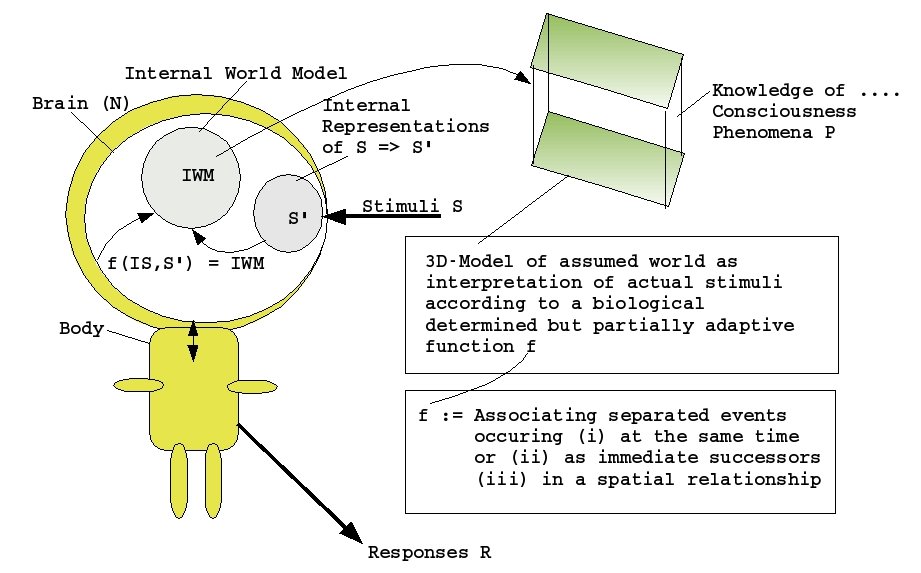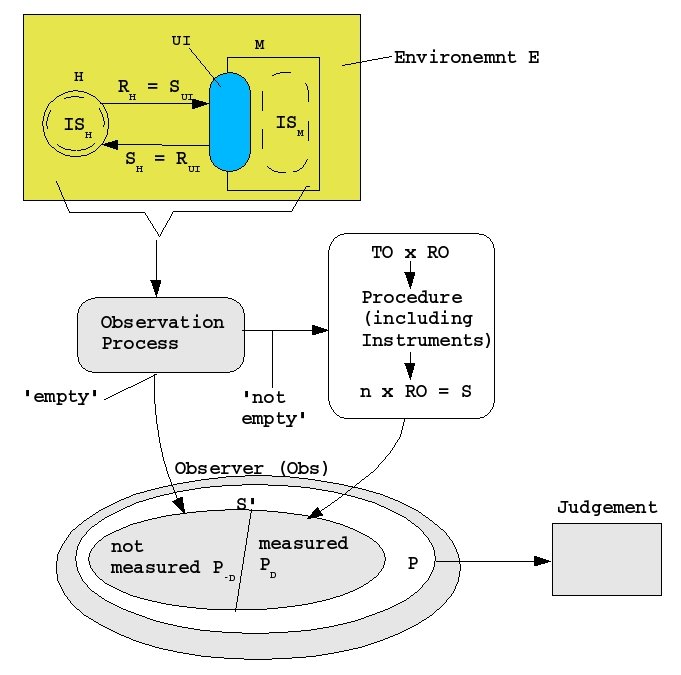
HMI/MMI/HCI
|
The general case of everyday observation is not sufficient for
scientific purposes. In the non-scientific
case the observer
(Obs) is
observing the
H-UI-M-Relationsship as an object without
additional aids, i.e.
the process of measurement is 'empty'. In this case does the observer
relays only on his subjective experience as far as this experience is
conscious. Thhis subjective experience is extremely powerful, because
it is based on a biological machinery which has evolved during about
3.8 billion years of biological life. But nevertheless this powerful
machinery is a dedicated machinery which certain inherent
properties which are influencing the construction
of the inner
model of the observer (cf. figure).
 |
| Figure: Basic epistemological
structure of
observer |
As we know today by neurobiology and neuropsychology
is the brain
(N) collecting all the different Stimuli (S)
from inside of
the Body (B) and is continuously
constructing an Internal
World Model (IWM) which is the hypotheses of the brain, how
all
these different individual stimuli can be arranged in a way which
represents their dynamics in a Presupposed
External World
(PEW), which is functioning as the outside Environment
(E).
In this perspective is the brain working as a function f mapping the
representations S' of Stimuli S of the external
world together
with numerous other Internal States (IS) into an internal
3D-Model of an assumed dynamic context of the individual
states IS
and S'. The presence of this model in the brain has the
'appearance' of 'Knowing of', i.e. the indiviual
biological
system, which is endowed with such a brain, has something
which
we call 'intuitively' Consciousness. We are aware
of
something. Philosophers are naming the 'content' of this kind
of
consciousness Phenomena (P)
(one of the most influencing writer for Phenomenology in Philosophy was
E.Husserl; for a critical discussion see (Petitot et al, 1999)).
Thus when an Observer (Obs) does
observe H-I-M-objects
(:= Human
<-->User Interface : Machine-interactions) the
observer does not perceive the 'object as such' (the 'Ding-an-sich of
Kant (cf. Kant, 1781/1787)), but only the stimuli, which the body has registerd and the model
of the object, which the brain has constructed. Because of the very
long co-evolution of body and brain with the environments, in which the
body occurs, is the internally constructed model --as everyday
experience shows-- for many purposes 'reasonably good', but with a
closer look to its output psychologists could find many kinds of distortions
which are inherent in this model. The internal model of the brain is
not a 1-to-1-mapping of the outside world, it is an ingenious
abstraction of important properties to enable the organism to respond
quickly and successfully for his purposes, but not
to
built an completely 'objective' picture of the
external world
(To cite the relevant literature for this argument one had
seriously to cite the whole history of philosophy and all of
modern science).
The question, how one can observe the real world to overcome this 'built-in' bias in observing the real world has led --step by step-- to the evelopment of modern sciences. To free the results of observations from the subjective internal states of a concrete observer one has to introduce procedures which are producing data which are independent from the person who is applying these procedures. These observation procedures can include all kinds of instruments. Using such kinds of measured data can improve the observations, but one has to keep in mind that the oberserver has to interprete these individual data as part of relations and dynamic sequences of events. For to do such an interpretation the observer has to construct explicit models (MOD) which are more powerful than the data as such. Therefore is this kind of model construction an area of potential distortions with regard to the real world 'as such'. The data D produced by such observation procedures are finally also phenomena PD (the internally represented stimuli S' which are 'measured') in the consciousness of some human observer, but these phenomena PD are a certain subset of the set of all subjective phenomena P, i.e. PD C P. The subset PD is characterized by the fact, that this subset PD is based on inter-subjective events D, which can be reproduced every time a person is applying the observation procedure.
As in the non-scientific case does the group of observers also
in
the scientific case need a language of
observation LObs
which
allows to speak about all objects, properties and actions involved in
this kind of observation.
 |
| Figure: Diferent Kinds of
Observation +
Measurement |
Furthermore one has to distinguish different kinds
of data
with regard to the object as such. Important basic types of data are:
Behavioral Data
(S-R)(Psychological, Black-Box): The observation process is
only
looking to the behavior of a system (H or M with UI). The
behavior is occuring as response R of a system to another system. For
the receiving system the perceived events are stimuli S. Thus the
response RUI of the user interface UI of some
machine
M can become the stimuli SH of a human
system H and
vice versa the responses RH of a human system H
can become
the stimuli SUI of some user interafce UI of a
machine M.
Restricting the observation of a machine M to its observable
input-output behvior(I-O) is also called Black-Box Method. In the
social
sciences is a behavior based approach (S-R) usually part of behavioral
(experimental) psychology.
Internal Data (IS)(Neuronal
(N),
Machine states (M)): If it is
possible to include the internal states IS of a system into the
observations, then does this provide an additional kind of data which
in the case of human systems H are called physiological or --more
specialized-- neurological (N) data, and in the case of a machine these
are called machine states (M). The disciplines, which are dealing with
internal states of human systems are Physiology and Neurology.
NeuroPsychological (S-N-R),
Black-and-White-Box (S-M-R): An important combination is the
combination of human behavioral (S-R) data and internal data
(N)
is called neuro-psychological data (S-N-R); in this case one correlates
behavioral (S-R) data with neuronal (N) data. In case of a machine one
has to combine input-output behavior (I-O) with internal machine states
M resulting in (I-M-O). The last kind of data leas to a
Blach-and-White-Box Approach.
Behavioral-Phenomenological (S-P-R): another possible combination in the case of human systems is the correlaion of behavioral data (s-R) with phenomenological data (P) to a phenomenpsychological approach (S-P-R).
NeuroPsychologicalPhenomenal
(S-N,P-R): recently based on the progress in
neurobiology
and new trends in philosophy one can observe first examples of
correlations of behavioral (S-R), neuronal (N), and phenomenal (P) data
to enable a more generalized and integrated theory.
Observation as such must not necessarily be a measurement
process.
To turn an observation into a measurement
process (MEAS) one has to compare some target
objects (TO)
with some reference objects (RO). And
in the scientific case the
target object (TO)
has to be compared to a reference object (RO) in a way
which is independent ('invariant')
from a concrete
observer.A measurement process invariant with regard to a concrete
observer
is called objective or empirical.
Simple examples from physics of reference Objects --which are also called standards-- are 'the meter [m]', 'the kilogram [m]', 'the second [s]'. Measurement in physics means that there exists some kind of a procedure during which a target object will be compared with a reference object --e.g. one side of a table with a meter-- and the result of the measurement will be a number telling 'how much times' the target object coult be compared to the reference object (e.g. 5 m, 7 kg, 8 s). There cann also be fractions or multiples of reference objects for to simplify the tak of measurement.
Thus we can say measurement (MEAS) is a mapping from TOs and ROs to numbers NUM:
MEAS: RO x TO ---> NUM
An important distinction here is fundamental masurement and derived mesaurement. Fundamental measurement (FMEAS) occurs if one is applying reference objects directly to target objects (like in the case of measuring the length of an object with a meter). Derived measurent (DMEAS) occurs if one is taking fundamental measures and combines these with formally defined operations into new values.